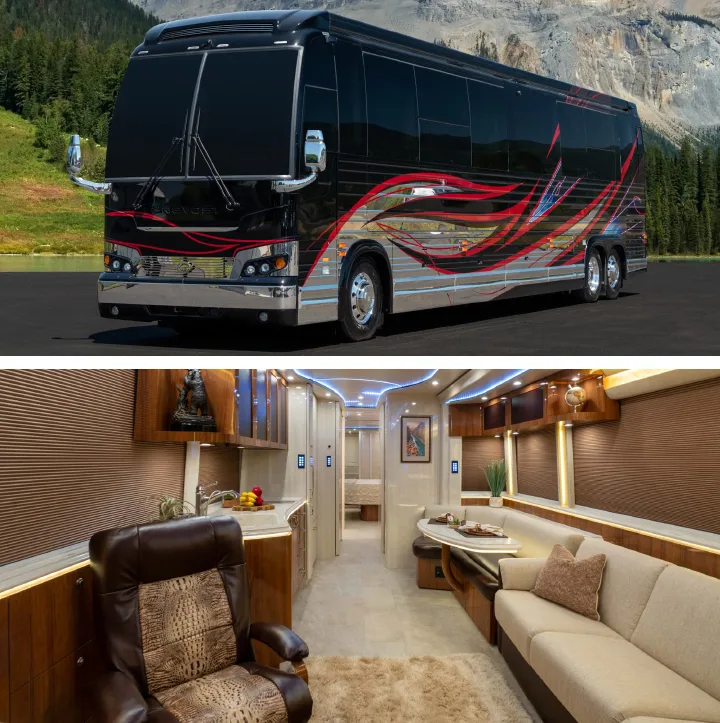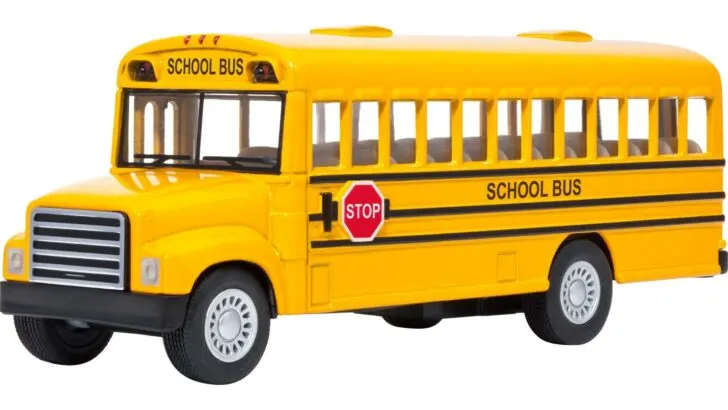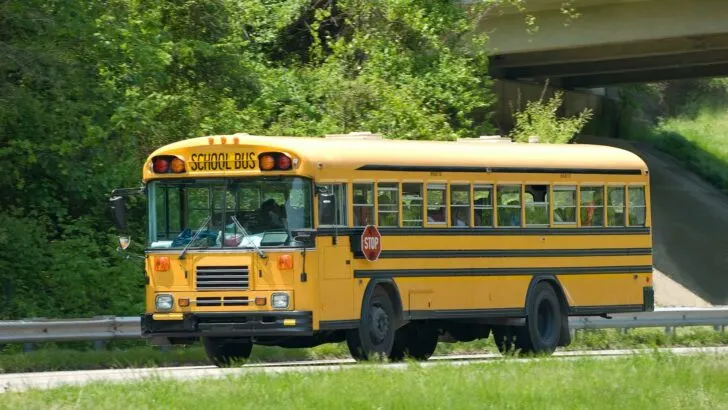Social media is full of pictures of people converting buses into rolling homes which essentially makes them RVs. But what exactly is a bus RV conversion? And is it worth the effort?
Today we’re looking at bus conversions (a sub-group of which are also known as skoolie conversions) – a different type of home on wheels!
What Is a Bus RV Conversion?
We all understand that the purpose of a bus is to carry multiple people from point A to point B.
A bus RV conversion is simply a bus that’s converted into an RV. This can be done professionally or as a DIY project.
When someone converts any type of bus into an RV, the bus essentially becomes a motorhome or, in some cases, a stationary tiny home.
A school bus conversion is a bus that was once used to transport school children that is later turned into a living space or RV. These conversions are often referred to as “Skoolies” as a result.
In general, the bus seats (or most of them) are removed. Then, the interior of the cavernous school bus undergoes a host of transformations that make it possible to live inside.
There are also buses that are specifically designed as semi-living spaces for traveling long distances. A good example of this would be buses owned by touring musicians. Their buses carry them from one tour destination to the next, but also have bunks for sleeping, toilets, and running water with holding tanks and lots of storage.
But touring musicians don’t typically live aboard those buses. They generally travel (and sleep) on the buses, and they live in hotels located at each of their touring destinations.
Actual bus RV conversions are intended to be used the same way that RVs are – as homes on wheels for use either part time or full time.
What Is a Skoolie?
As mentioned above, “skoolie” or “skoolie conversion” is a nickname given to school buses that are converted into RVs.
These can be full-size school buses or short buses, but if they were built to shuttle kids to and from school, they’re frequently referred to as “skoolies”.
A skoolie conversion is simply an RV that was a school bus in a former life.
How Are Buses Converted to RVs?
There are a couple of different ways to go when converting a bus to an RV. Each has its pros and cons, but the end result is similar in that the bus becomes a living space, as you would find in an RV.
Commercial Bus RV Converters
Commercial bus RV converters can take a bus chassis, like a Bluebird bus often used for transporting school children, and custom build it into an RV.
A good example of this would be the Wanderlodge.
Wanderlodges started out as Bluebird buses and, until 1998, they were converted by Bluebird into high-end RVs.
Thereafter, they started converting transit buses into Wanderlodges giving them pusher engines, three axles, slides, and other typical motorhome features.
The last generation of Wanderlodges compared fairly closely with the Prevost-based luxury conversions we see on the market today.
High-end commercial bus RV conversions (like those designed from Prevost or MCI bus chassis) are most often converted by a commercial conversion company. The resulting RV is an incredibly luxurious high-end home on wheel… that also has the advantage of being built on an extremely robust chassis. These rigs are designed to be driven a million miles or more!
A couple of high-end bus conversions companies are Marathon Coach and Featherlite Coaches.

The exterior and interior of a Prevost bus RV conversion. (Photo credit: Marathon Coach)
DIY Bus RV Conversions
A DIY bus RV conversion is where the bus chassis or school bus is purchased by an individual with the idea of converting it into an RV.
This has become a popular trend in recent years! Social media is full of photos of former buses (skool conversions, in particular!) that have been purchased and converted by their new owners.
Typically, owners will tear out all or most of the bus seats (other than the driver’s seat, of course). After that, they’ll build in a new floor, add insulation, and create a “galley” kitchen area. Depending on their design, they’ll most often include some amount of living area, a bathroom, and at least one bed.
Entire families travel and live in DIY bus RV conversions. Some bus conversion owners who have land where the bus can be stationary use the bus conversion as a tiny house as opposed to a traveling RV.
Is it Cheaper to Buy an RV or Convert a Bus?
It’s actually cheaper to convert a bus than it is to buy an RV — in general. Of course, this is not always the case. However, an RV is generally more expensive than a bus conversion.
According to Popular Mechanics, in fact, a bus conversion generally costs roughly 10% of the cost of a used RV. They estimate that the average conversion including full hookups can be built for around $30,000.
Many have been built for significantly less, and many for considerably more. The cost of a bus conversion depends on the design and how thrifty the DIYer is.
But in general, bus conversions are less expensive than purchasing an RV.
Is an RV Safer than a Bus Conversion?
Let’s start by saying that both are designed to be safe. But, a bus conversion is considered by many to be safer than a purpose-built RV.
Many RVs are boxes (called the house) that are typically constructed of particleboard, fiberglass, and plastic that is built onto various sizes, makes, and types of chassis. In contrast, buses are constructed of metal (often aluminum) in a way that the body portion(s) provide structural support and rigidity to the vehicle. In the case of school buses, they’re even made of steel. The arch of the roof and the strong internal steel ribs of a school bus contribute to their safety.
Even the windows of a bus are usually framed in steel and bonded in place so that they contribute to the overall strength of the wall structure.
Generally speaking, a bus RV conversion’s weakest link is the build. Any conversion, whether it’s a van, a bus, or any other vehicle, is only as safe as the converter makes it.
If everything in the bus is securely anchored, all electrical components are safely connected, and all seatbelts adhere to safety regulations (NHTSA Standard No. 209), a bus RV conversion can be far safer than many purpose-built, fiberglass RVs.
The problem is that many DIYers aren’t sure how to properly anchor everything in the bus. They may not be sure how to make electrical components safe. They may be using propane appliances in an unsafe manner or be unsure of some important mechanical safety components of the bus.
This is where professional converters really shine, of course. But professional bus conversions are generally very expensive.
What is the Best Bus to Convert Into an RV?
This is a difficult discussion to have because there are so many opinions about why certain buses are best as RV conversions.
There are several bus types to choose from including dog nose (conventional) skoolies and flat-nosed (transit) skoolies.
There are buses with engines in the front and there are buses with engines in the rear.
Conventional dog-nose style buses tend to be cheaper to buy, are said to be fairly easy to work on, and are quite readily available on the market. Combined, these factors make them a popular choice for bus RV conversion as well.

A dog-nose (conventional) school bus has the engine in the front (nose).
However, bus drivers who have driven both types of buses tend to favor the flat-nose transit/touring buses, partly because they have excellent visibility.
They also offer a higher GVWR (Gross Vehicle Weight Rating) which can be important for a bus RV conversion.
Ultimately, the general consensus may be that the flat-nose transit buses make the best conversions.

A flat-nose (transit) school bus could have the engine in the front or the rear (pusher).
But, there are front-engine flat-nose transit buses and rear-engine flat-nose transit buses. Each has its pros and cons, and determining which is preferable is best left up to the bus owner.
Diesel pusher school buses, flat-nose transit buses with the engine in the rear, are a relatively popular option for a bus RV conversion.
In addition to the great visibility, they can be found with the larger 8.3L Cummins engine, they’re quieter, and many of them have huge underbelly storage compartments. Not only are these great for storing lots of stuff, but when building the rig you can run heating ducts, plumbing, and even electrical systems in these areas.
Some of these transit buses have larger windows and a longer wheelbase which can offer a smoother ride.
And finally, they tend to have more interior space than conventional skoolies of equal length.
There are a few drawbacks of the flat-nose transit style buses, of course.
If the engine is at the rear of the bus, this means that you don’t have that large rear door if that’s something you’re interested in having.
Also, the underbelly storage area means lower ground clearance. Not many people are going to take their skoolie conversion off-roading, of course, but the lower ground clearance may be a factor in some situations.
And finally, the approach angle of a conventional bus is preferable to that of a flat-nose transit bus.
Still, the transit buses seem to be a favorite among many bus-to-RV converters.
We want to make clear that we’re not advocating for either, as we’ve never converted a bus ourselves. We also recognize that one type of bus may be best for one situation while another type is best for a different situation!
Should I get an RV or Build a Skoolie?
That’s a question we can’t answer, because again, it depends on your situation. Only you know how you intend to travel and where, what your budget is, and what your DIY skills are like.
However, there are a few things you can keep in mind as you make your decision.
First, a skoolie conversion takes a lot of time and requires a lot of work to build. If you’re not skilled in certain facets of building, there could be issues. And while we all have issues with our rigs from time to time, you definitely want to steer as clear of safety issues as possible.
So, honestly evaluate your ability to convert a bus. Take a look at Buslandia for some great information and general ideas. Reading through their site can help you choose a bus, strip a bus, and build out a bus.
You also want to keep in mind that not every campground and RV park will accept a converted school bus. In fact, you could run into many that won’t.
You may have read or heard about the RV park 10-year rule. Well, that could apply to your converted bus as well, so be aware of that.
You’ll also want to be sure you’re comfortable with approach and departure angles, though this is also true of a Class A RV, as are other driving skills.
You may want to watch our driving school videos for a few tips from a professional bus driving instructor that would be helpful.
Geek Out With Us Every Week
Join our newsletter to learn about all things RV-related. Every week we offer free tips, tricks, product reviews, and more to our online community of RVers. So, whether this is your first time on the road or you’re a seasoned expert, we’d love for you to geek out with us!


Bob
Tuesday 14th of November 2023
Actually, Wanderlodges were not Bluebird school bus conversions, but a ground up build in a separate facility operated by Bluebird. They were designed, engineered and constructed in total as high end motor coaches.
To this day, they are highly regarded and sought after as their quality and safety exceed most anything available today; almost a cult following. Many from the 70s and 80s are still on the road today, a testament to the high level of build quality.
Their production ended in 2010 due to the financial conditions of the time and Bluebird’s focus on their core business.
Randy Dupre operates the Wanderlodge owners group (WOG) web site that is the must comprehensive source of all things Wanderlodge…